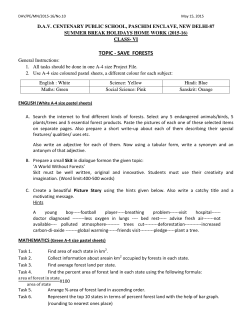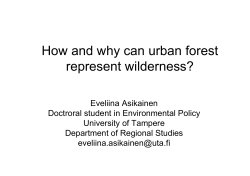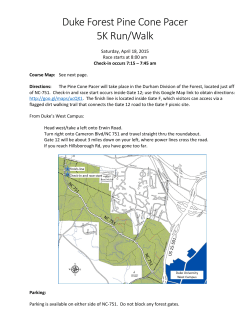
Forests & Forest Products as Carbon Sinks
Forests & Forest Products as Carbon Sinks Led by Forests & Forest Products as Carbon Sinks Forests and the Climate Challenge Global temperatures are increasing and science has confirmed that we must limit the rise to under 2°C in order to avoid the most serious consequences for people, the environment and economies worldwide. Forests cover around 30% of the Earth’s land surface, storing and food is increasing. approximately 638 gigatonnes of carbon. This is more that the natural forests, it will be necessary to expand natural forests In addition to preserving primary total amount of carbon in the entire atmosphere. Sustainable under sustainable management. Meeting the increased forest management and the wise use of forest products are demand means increasing the amount of planted forest in currently the most practical ways to remove carbon from the degraded areas by around 400 million hectares. atmosphere at scale and at low cost. However, forests are disappearing at a rate of over 13 million hectares per annum while the demand for wood, fiber, fuel, Forests as Carbon Sinks WBCSD works with member companies in the forest products value chain, from pulp and plantation businesses to the users of forest products and suppliers to the sector. These companies are committed to ending deforestation and eliminating illegal wood from supply chains. By protecting forests we prevent millions of tonnes of greenhouse gas from entering the atmosphere and by expanding the area of forested land we Forest Products and the Bio-economy Forest products are key to making the transition to a more resource efficient society. Harvesting forest-based products sequesters carbon at the rate of 189 million tons per year (across a variety of time scales, according to the different products and applications). create new carbon sinks and provide other valuable ecosystem services. Low Carbon Technology Partnerships initiative 35 Led by Forests & Forest Products as Carbon Sinks Scaling up Forests and Forest Products as Carbon Sinks in the context of the UNFCCC COP21 in Paris WBCSD and its member companies have identified Forests and 2. Innovation and technological development in pulp Forest Products as Carbon Sinks as a key area for collective processing: There are currently technologies in the pre- action on the climate challenge. In the run-up to COP21, the commercialisation phase that reduce the emissions work program will be developed within the context of the Low intensity of pulp processing by up to 70%. These new Carbon Technology Partnerships initiative (LCTPi). applications have the potential to displace processes that use fossil fuels, or free up surplus energy from biomass A range of solutions are being developed and tested in different plants that can then be used by other sectors or exported regions. The solutions are focused on three areas: onto electricity grids. 1. Sustainable forest management: Mechanisms to reduce the rate of deforestation, improve degraded forest landscapes 3. Forest products: Exploring innovations such as wood and increase the area under forest cover, especially in areas where land degradation, watershed protection and marginal agricultural productivity are considerations for land managers. composite materials, biofuels and the application of forest products into industrial processes such as steel-making. The group will report on mechanisms to increase the demand for forest products that can sustain the growth of sustainably managed forests without timber from unsustainable sources of supply (deforestation). Low Carbon Technology Partnerships initiative 36 Forests & Forest Products as Carbon Sinks Led by Work Program and Timeline BASELINE Identify the baseline of global forest carbon stocks and levels of sustainable production FORESTS AND FOREST PRODUCTS 2050 VISION Develop a shared vision with clear targets and milestones for the greater use of forest products from sustainably managed forests BARRIERS, CHALLENGES, GAPS Identify barriers and challenges to achieving the 2050 vision BIG SOLUTIONS BEYOND BAU Beyond business as usual actions delivered through private and public partnerships How to Get Involved Matthew Reddy Director, Forest Solutions * reddy@wbcsd.org Low Carbon Technology Partnerships initiative 37 Led by COP21 and the LCTPi About COP21 and the LCTPi In December 2015, a global climate agreement will be brokered LCTPi is a collaborative platform, gathering together project at COP21, the Paris Climate Change Conference. This is a key teams and stakeholders to discuss and agree the concrete moment for all stakeholders to contribute to decisive climate actions that are needed. It focuses on solutions that are beyond action. business as usual. It is a unique opportunity to showcase how your business can and is tackling climate change. Launched in Lima in partnership with SDSN and IEA, LCTPi is supported by the French Presidency of COP21 and is part of To ensure the development and implementation of business the Lima-Paris Action Agenda. It aims to present action plans solutions that address climate change, we must: at COP21 that will accelerate low-carbon technology and scale Remove the barriers that are preventing existing solutions up the deployment of business solutions consistent with the from being deployed 2˚C objective. Develop new solutions to complement existing ones Low Carbon Technology Partnerships initiative 38 COP21 and the LCTPi Led by LCTPi has several focus areas, and for each area the deliverables include: Business oriented solution roadmaps including critical Strengthened business and government dialogue to create milestones Analysis enabling frameworks for investment of barriers and identification of solutions, A work program beyond Paris to ensure enduring financial requirements, policies and PPP (public-private implementation at scale partnerships) opportunities that facilitate scale up Underway Renewables Carbon Capture & Storage Energy Efficiency in Buildings Materials: Cement Sustainability Initiative Advanced Biofuels Climate Smart Agriculture Forests & Forest Products as Carbon Sinks Low Carbon Freight Transport Low Carbon Passenger Mobility Materials: Chemicals Digitization Scoping Smart Grids Low Carbon Technology Partnerships initiative 39 Led by Led by P Partners http://lctpi.wbcsdservers.org/the-solution/
© Copyright 2025









